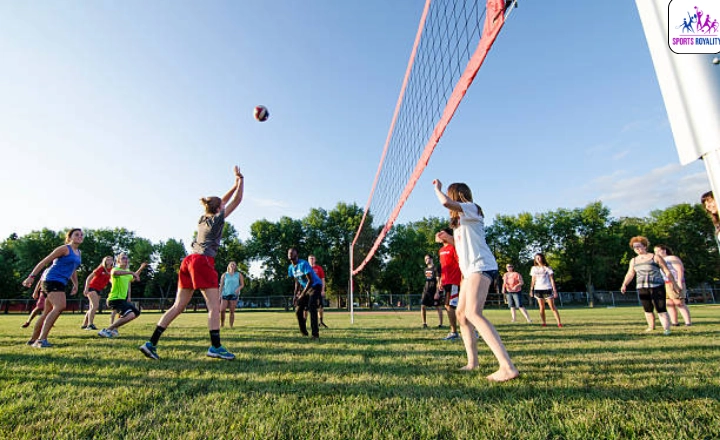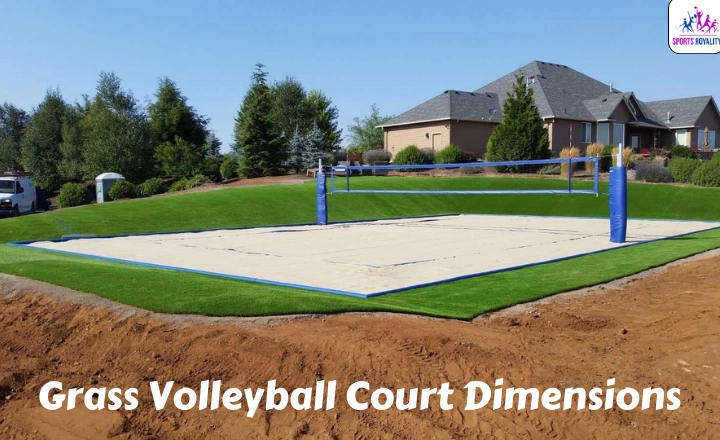Grass volleyball has been a beloved summertime pastime for decades, with its laid-back atmosphere and competitive yet friendly nature. As you gather with friends or teammates on a sunny day, there’s nothing quite like the feeling of sinking your toes into the soft grass, ready to dive for that perfect spike. But have you ever wondered about the dimensions of a grass volleyball court? From the net height to the boundaries that define fair play, understanding these measurements is essential for both casual players and aspiring professionals alike. We will explore the official grass volleyball court dimensions, providing you with all the knowledge you need to step onto the green and serve up some unforgettable games!
Grass Volleyball Is Closer To Indoor Than Beach

Grass volleyball, known for its fast-paced and unpredictable nature, is often assumed to be similar to beach volleyball due to the natural surface on which it is played. This assumption overlooks the fact that grass volleyball is actually closer in style and technique to its indoor counterpart. Unlike the sandy terrain of beach volleyball, grass provides a stable and consistent surface that allows players to focus more on their movements and positioning.
On a grass court, agility becomes paramount as players need to quickly react and adjust their movements during rallies. The reduced sand resistance makes explosive bursts of speed possible, enabling players to cover large distances in a short amount of time. The familiarity with indoor techniques such as defence positioning and setting plays an important role on grass courts where quick reflexes are essential for effective play.
While both beach and grass may share some similarities due to their outdoor settings, understanding that grass volleyball mirrors indoor techniques can greatly benefit newer players. Developing efficient movement patterns on such surfaces is crucial for maximizing performance in terms of speed, agility, and overall game strategy. So next time you step onto a grass court with those unfamiliar spikes beneath your feet, embrace the opportunity to refine your skills by blending indoor tactics with outdoor finesse you might just find yourself gaining an edge.
Grass Sixes (6 v 6)- Grass Volleyball Court Dimensions
The standard dimensions for this format are 18 x 9 meters (59 x 29.6 feet). Why is this specific size considered appropriate? Well, imagine a court that is too small; players will constantly feel cramped and restricted in their movements. An excessively large court would make it difficult for players to cover ground swiftly or efficiently communicate with their teammates.
By adhering to the recommended dimensions, players can experience the perfect balance between freedom of movement and strategic placement. With ample space on both sides of the net, athletes can perform dynamic dives, lunges, and powerful spikes without worrying about colliding with boundaries or spectators.
These ideal court dimensions lend themselves to exhilarating rallies where athletes must strategize effectively while incorporating agile footwork to retrieve challenging shots. By providing just enough room for athleticism and tactical play on grass sixes volleyball courts, players are able to reach their full potential in every aspect of the game.
Grass Fours (4 v 4) Volleyball Court Dimensions
The measurements for a grass fours game are 18 x 9m (59 x 29 6 ft). This slightly smaller size compared to indoor courts allows for a faster-paced and more dynamic game. The reduced court area forces players to cover more ground quickly, making it an exciting challenge that requires agility and teamwork.
When it comes to beach volleyball, the dimensions differ slightly. The FIVB (International Volleyball Federation) uses a slightly smaller court size of 16 x 8m (52.5 x 26.3 ft) for beach matches. This adjustment takes into account various factors unique to playing on sand, such as physical strain and slower movement on this surface.
The difference in court dimensions between grass fours and beach volleyball highlights how slight changes can completely alter gameplay dynamics in different environments. Adapting the size of the playing area not only adds excitement but also creates a distinct set of challenges for athletes to overcome.
Grass Triples (3 v 3) Volleyball Court Dimensions
The most commonly used dimensions for this type of court are 18 x 9 meters (59 x 29 feet 6 inches). This size offers a perfect balance, providing enough space for players to move around while still creating an intimate and intense playing environment.
One interesting aspect to consider is that these dimensions can vary slightly depending on regional preferences or personal customization. Some players may opt for slightly larger or smaller courts based on their skill level, physical abilities, or strategic preferences. This flexibility further adds to the beauty of grassroots volleyball, as it allows individuals to adapt the game according to their specific needs.
Having these standardized dimensions provides consistency across different competitions and ensures fair play. Players can hone their skills knowing that they will encounter similar court sizes in various tournaments around the world. It allows them to understand how best to position themselves, plan their strategies, and anticipate how the ball will travel within this confined space. Understanding the significance of having consistent grass triples volleyball court dimensions enhances both player development and the overall quality of matches played at all levels.
Grass Doubles (2 v 2) Volleyball Court Dimensions
With its size measuring at 16 x 8 meters, the court allows for players to maximize their agility and speed while reacting to each other’s moves quickly. The smaller area creates a more intense and competitive atmosphere, where every movement counts.
The compact size of the grass doubles court encourages communication and teamwork between players. With only two athletes on each side of the net, there is minimal room for error or miscommunication. This forces teammates to constantly communicate and coordinate their strategies in order to cover as much ground as possible and outwit their opponents.
Playing on a restricted area requires players to possess strong spatial awareness skills. They must adapt their positioning swiftly and anticipate their opponents’ moves accurately to avoid being caught off guard. The smaller dimensions also lead to shorter rallies with faster pace, making quick reflexes and precise ball control essential.
Grass Volleyball Net Size & Height-Outdoor Volleyball Court Size
The Grass Volleyball Court Dimensions both in terms of size and height play a crucial role in determining the dynamics of the game. With men’s and coed nets positioned at an impressive 2.43m (7 feet 11 5/8 inches), players are required to summon their athleticism to reach new heights. This higher net height not only adds an element of challenge but also amplifies the excitement for both players and spectators alike.
Women’s grass volleyball nets stand slightly lower at 2.24m (7 feet 4 inches). While this might seem like a significant difference, it serves to level the playing field for female athletes who may not have the same vertical leap as their male counterparts. This slight adjustment ensures that women can showcase their skills and compete at an equally high level without compromising on the integrity of the game.
Beyond its height, a standard outdoor beach volleyball net measures 32 feet long by 39 feet wide at the top. These measurements create space that challenges players’ spatial awareness while allowing them enough room to strategize, maneuver swiftly on sand, and execute perfect sets or powerful spikes. The dimensions strike a balance between providing athletes with ample room for strategic plays while keeping everyone engaged within close proximity.
Final Word About Grass Volleyball Court Dimensions
Understanding Grass Volleyball Court Dimensions is essential for players, coaches, and organizers alike. The standard measurements of 18 meters long and 9 meters wide provide a fair and balanced playing field for both teams. Properly marking the court with boundary lines and attack lines ensures clarity during gameplay. Considering factors such as soil quality and drainage can greatly contribute to the overall condition of the court.
By adhering to these dimensions and maintaining the court accordingly, players can fully enjoy the sport while organizers create a professional and safe environment for all involved. So, whether you’re a player or an organizer, make sure to pay attention to these dimensions to enhance your grass volleyball experience!
FAQs
Can I modify the dimensions of a grass volleyball court for recreational play?
While it’s best to stick to the official dimensions, you can modify them slightly based on available space as long as you maintain a rectangular shape and keep the net at an appropriate height.
Can I use regular lawn grass for my grass volleyball court?
It is not recommended to use regular lawn grass as it may not provide adequate traction or withstand heavy foot traffic. Instead, opt for specialized turf or sand that is suitable for volleyball courts.
Can I host tournaments on a grass volleyball court with these dimensions?
Yes! Grass courts with official dimensions provide an excellent venue for hosting competitive volleyball tournaments, attracting players and spectators alike.

